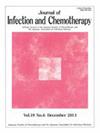作为艰难梭菌感染发展新指标的抗菌药组合:日本基于人群的嵌套病例对照研究--静冈国宝数据库研究》。
IF 1.9
4区 医学
Q3 INFECTIOUS DISEASES
引用次数: 0
摘要
背景:艰难梭菌是导致抗菌药物相关性结肠炎的主要原因。虽然抗菌药物管理降低了艰难梭菌感染(CDI)的发病率,但由于医护人员对预防艰难梭菌感染的知识有限,因此管理艰难梭菌感染仍具有挑战性。为了解决这个问题,我们研究了抗菌药物使用与 CDI 发病之间的关系:这项观察性、巢式病例对照研究是利用静冈国宝数据库(SKDB)进行的。病例组包括在加入 SKDB 后 1 年内没有 CDI 或抗菌药物相关性小肠结肠炎记录,但随后患上 CDI 的患者。对照组包括通过 1:4 匹配抽样选出的个体,不对性别、年龄和 CDI 发病月份进行替换。在控制匹配变量、背景因素和基础疾病的情况下,进行了条件逻辑回归分析,以评估抗菌药物使用(数量和组合)与 CDI 发病之间的关联:在 2,398,393 人中,4917 人被分配到病例组,19668 人被分配到对照组。使用一种抗菌药的 CDI 调整后几率比(ORs)为 3.65,使用两种、三种或四种以上抗菌药的调整后几率比(ORs)分别为 8.58、17.3 和 38.9(均为 p):CDI 感染率随着联合使用的抗菌药物种类的增加而增加。某些类型或组合的抗菌药物可能会增加 CDI 的发生率。本文章由计算机程序翻译,如有差异,请以英文原文为准。
Antimicrobial Combinations as Novel Indicators for Clostridioides difficile infection development: Population-Based, Nested Case-Controlled Study in Japan—The Shizuoka Kokuho Database Study
Background
Clostridioides difficile is a major cause of antimicrobial-associated colitis. While antimicrobial stewardship has reduced the incidence of C. difficile infection (CDI), managing CDI is challenging because knowledge about preventing it is limited among healthcare professionals. To address this, we examined associations between antimicrobial use and CDI development.
Methods
This observational, nested case-controlled study was conducted using the Shizuoka Kokuho Database (SKDB). Individuals with no record of CDI or antimicrobial-associated enterocolitis within 1 year after SKDB enrolment, but who subsequently developed CDI, were included as the Case group. The Control group comprised individuals selected via 1:4 matching sampling without replacement for sex, age, and month of CDI onset. Conditional logistic regression analysis was performed to assess associations between antimicrobial use (number and combination) and CDI development, controlling for matched variables, background factors, and underlying conditions.
Results
Of the 2,398,393 individuals, 4917 were assigned to the Case group and 19,668 to the Control group. The adjusted odds ratios (ORs) for CDI were 3.65 for one antimicrobial and 8.58, 17.3, and 38.9 for combinations of two, three, or four or more agents (all p < 0.001). Penicillins, fourth-generation cephems, and carbapenems exhibited high ORs. Similar results were observed in certain demographic and comorbidity-free subgroups. Several combinations (penicillins + carbapenems, penicillins + cephems + carbapenems, cephems + fluoroquinolones, and penicillins + cephems + carbapenems) were notably associated with CDI development.
Conclusion
CDI prevalence increased with the number of antimicrobial classes used in combination. Certain types or combinations of antimicrobials may increase the OR for CDI.
求助全文
通过发布文献求助,成功后即可免费获取论文全文。
去求助
来源期刊

Journal of Infection and Chemotherapy
INFECTIOUS DISEASES-PHARMACOLOGY & PHARMACY
CiteScore
4.10
自引率
4.50%
发文量
303
审稿时长
47 days
期刊介绍:
The Journal of Infection and Chemotherapy (JIC) — official journal of the Japanese Society of Chemotherapy and The Japanese Association for Infectious Diseases — welcomes original papers, laboratory or clinical, as well as case reports, notes, committee reports, surveillance and guidelines from all parts of the world on all aspects of chemotherapy, covering the pathogenesis, diagnosis, treatment, and control of infection, including treatment with anticancer drugs. Experimental studies on animal models and pharmacokinetics, and reports on epidemiology and clinical trials are particularly welcome.
 求助内容:
求助内容: 应助结果提醒方式:
应助结果提醒方式:


